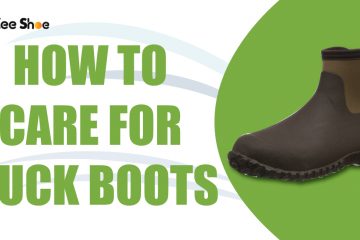Muck Boots are a type of rubber boot often worn while working in wet, muddy, or cold environments. They are popular among farmers, hunters, construction workers, and other people who work outdoors.
But how good are muck boots? Do they provide the protection and comfort that people say they do?
In this blog post, we will look at muck boots and see what kind of benefits they offer. We will also discuss some of the drawbacks of these boots and help you decide if they are right for you. So let’s get started!
What are muck boots?
Muck boots are rubber boots designed to protect the wearer’s feet from cold, wet conditions. Muck boots were created by a company called Muck Boot Inc. in Ohio.
The boots have a flexible design and thin soles, making it easier for the wearer to move around on slippery surfaces. The thin sole also helps ensure that the wearer can maintain a firm grip on the ground while walking in mud, snow, and other potentially slippery surfaces.
Muck boots are typically made from rubber and lined with thermal insulation.
How well do they work?
Muck boots work quite well in maintaining warmth and protecting your feet from getting wet. The insulation that lines the boots will keep your feet warm in cold weather.
And the rubber exterior of the boot is nearly impenetrable, so it is quite strong and durable. However, muck boots are not particularly good at protecting your feet from sharp objects, such as rocks or nails.
This can lead to injuries if you are not careful while wearing them!
Who should wear them?
Muck boots are most commonly worn by people who work outdoors during wet or cold seasons. Hunters, farmers, construction workers, hikers, and fishermen all typically wear these boots when working outside in these conditions.
Muck boots can also be worn indoors if you’re doing a messy job that requires getting very dirty (e.g., gardening). Because they are easy to slip on and off, muck boots can be worn to replace your regular footwear.
Where can you buy them?
Muck boots are typically available in farm supply stores, sporting goods stores, online retailers, large superstores, and hardware stores.
You can also find them at pet shops that sell dog supplies because they are very popular among duck hunters who use the boots when walking through wetlands.
Muck boots usually range between $30-50 depending on the style and boot being purchased. However, you may be able to find cheaper models if you shop around for deals or look for coupons or promotional codes.
What are the benefits of wearing muck boots?
There are many benefits associated with wearing muck boots. We’ve outlined the most important ones below:
- Muck boots are sturdy and durable, holding up to difficult conditions such as snow, ice, rocks, thorns, and water.
- The rubber exterior is protective and flexible, so it is less likely to crack or tear.
- Thermal insulation lining helps keep the wearer’s feet warm even in cold weather conditions. These insoles also reduce sweating inside the boot, which keeps your feet dry.
- Rubber soles provide great traction on slippery surfaces like mud or snow. This makes it easier for you to walk without slipping and falling! • Muck boots are lightweight yet sturdy – this gives them a nice balance of durability without sacrificing comfort.
Muck Boots are very popular for people that work outdoors or in wet conditions. The boots are not too expensive and can also be worn indoors.
How to properly care for your muck boots?
Having a pair of muck boots comes with its responsibilities: properly caring for your boots! Here’s what you should do to keep them clean, odour-free, and looking like new:
- It is advised that you air out your boots after wearing them each time because they may begin to build up moisture inside the boot if they remain damp. Use cedar shavings, baking soda, or newspaper balls to remove any moisture that would cause the insoles to rot away.
- To minimize the chance of ruining your boots, avoid using them on rough surfaces like rocks or pavement.
- Keep mud and dirt out of the treads! This will ensure that you maintain good traction on slippery surfaces so you don’t fall.
- If possible, store your muck boots in a cool, dry place where they will not be exposed to too much direct sunlight. Exposure to extreme temperatures can damage your boots’ rubber material, which would result in cracking or peeling over time!
- Overall, muck boots provide crucial protection and warmth during wet or cold conditions. They are also lightweight yet sturdy for added comfort. However, you must take care of them properly, so they do not get damaged or ruined.
FAQ’s:
Here are a few frequently asked questions about how good are muck boots.
How do I clean my muck boots?
To clean your muck boots, wipe them down with a damp cloth and let them air dry. If your boots are particularly dirty and require a more thorough cleaning, use mild soap and warm water to remove caked-on dirt and mud.
Be sure to rinse off all soap and water thoroughly! Once the boots are dry, apply a thin layer of waterproofing wax or mink oil with a clean cloth and let it absorb for 5-10 minutes.
Buff any excess wax using a clean cloth and repeat this process until your boot is properly moisturized.
How do I store my muck boots?
It is recommended that you do not store your muck boots in a closed area because this would cause them to accumulate moisture, leading to a loss of insulation or a build-up of mould and mildew.
If possible, place the boots in a cool, dry place where they will be protected from direct exposure to sunlight.
Are muck boots waterproof?
Usually, yes! Muck boots have a sturdy yet flexible rubber exterior that keeps water out while also providing insulation, so the wearer’s feet remain warm and dry.
However, this sensitivity to moisture can cause them to be more vulnerable than steel-toed boots. For this reason, you must air your boots out after wearing them each time to avoid the accumulation of moisture inside the boot.


